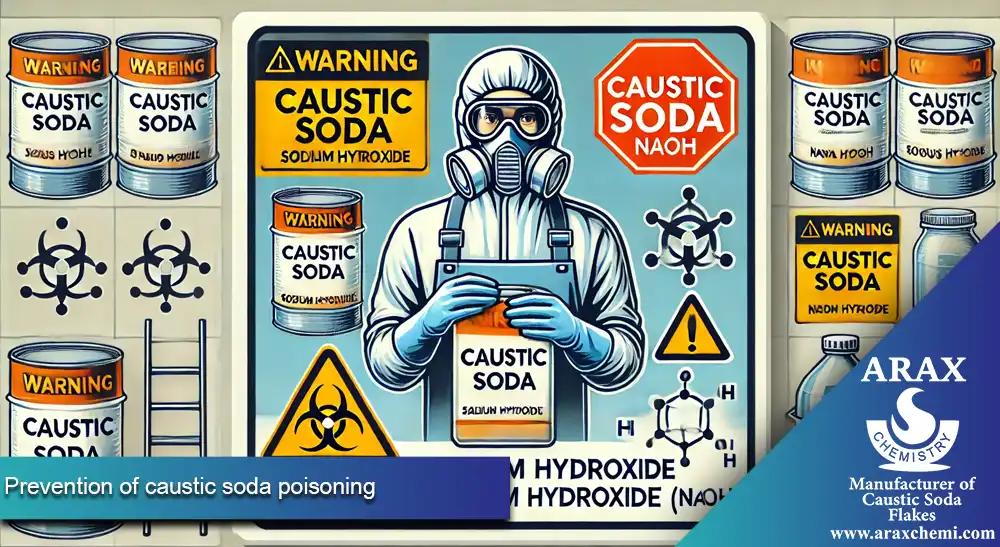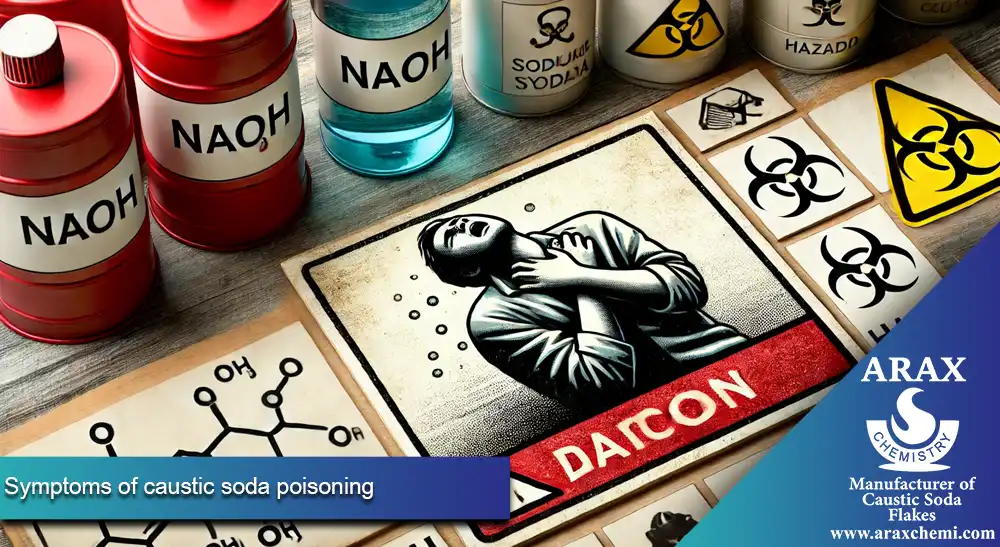Caustic soda poisoning is one of the most significant hazards associated with handling this widely used chemical. Since caustic soda is not only utilized in industries but also has numerous applications at home, it is essential to learn the fundamental principles of working with it to prevent poisoning and injuries. This article provides a comprehensive overview of the various routes through which caustic soda can cause poisoning, as well as methods for prevention and treatment.
Caustic Soda and Its Uses
Caustic soda, also known as sodium hydroxide, lye, or caustic soda, is a white, odourless, highly alkaline solid that readily absorbs moisture from the air. It is produced in forms such as solutions, powders, and pearl-like granules. When caustic soda is dissolved in water or acid, it releases a significant amount of heat, which is sufficient to ignite combustible materials. This substance is used in the production of soap, paper, explosives, paint, adhesives, petroleum products, metal processing, electroplating, textiles, and more.
Caustic soda should be stored in a cool, dry place with proper ventilation. Due to its high reactivity, it should not be stored near organic materials, oxidizers, acids, or metallic powders. Additionally, when purchasing caustic soda, ensure that the manufacturer has adhered to strict packaging standards. If the packaging is damaged or of poor quality, it is advisable to transfer the caustic soda to a more secure container.
Routes of Exposure to Caustic Soda
Inhalation:
Inhaling sodium hydroxide vapour can irritate the mucous membranes of the nose, throat, and respiratory system. The vapour is odourless, making it impossible to detect its concentration by smell. Irritation of the mucous membranes serves as a warning sign of acute exposure to caustic soda vapour. Workers who are exposed to sodium hydroxide vapour for extended periods may develop some resistance to its irritating effects. The vapour can hydrolyze proteins in tissues, leading to cell destruction. Children are at a higher risk because their shorter stature means they are closer to the ground, where the vapour is more concentrated. Additionally, children have narrower airways than adults, making them more susceptible to breathing difficulties and suffocation.
Skin/Eye Contact:
Direct contact with liquid or solid caustic soda can cause irritation and burns. The severity of burns increases with the concentration of caustic soda, penetrating deeper into tissues. Robust sodium hydroxide solutions can hydrolyze proteins in the eyes, resulting in severe burns and damage, potentially leading to blindness.
Ingestion:
Swallowing caustic soda can cause severe damage to the lips, tongue, mouth, esophagus, stomach, and the entire digestive system.
Health Effects of Caustic Soda Exposure
Sodium hydroxide is highly corrosive and irritating, capable of causing severe burns and permanent tissue damage. Damage to certain areas, such as the respiratory system, may not become apparent until several hours after exposure. When purchasing caustic soda, it is crucial to pay attention to its purity level. Contact with solutions containing 25-50% sodium hydroxide causes immediate irritation, while solutions with 4% or lower may not produce noticeable reactions for several hours. Additionally, eye damage may not become evident until up to 72 hours after exposure. The primary risks associated with caustic soda include:
Respiratory Effects:
Inhaling caustic soda vapour can immediately irritate the respiratory tract. High doses of vapour can lead to swelling or spasms in the larynx, obstruction of the upper airways, and suffocation. It can also cause lung inflammation and fluid accumulation in the lungs. Children are more vulnerable due to their smaller airway diameter, and individuals with asthma or emphysema are particularly susceptible to caustic soda poisoning.
Skin Contact:
Contact with solid or concentrated caustic soda solutions can result in severe burns and deep tissue injuries. The pain and burning sensation from contact with concentrated solutions typically appear within three minutes, whereas exposure to diluted solutions may not produce symptoms for several hours.
Eye Exposure:
When caustic soda comes into contact with the eyes, it can cause clotting, rupture of blood vessels, and fluid accumulation. Common eye injuries include corneal softening, detachment, and ulceration. Without prompt treatment, these injuries can worsen over several days, potentially leading to blindness.
Gastrointestinal Effects:
Symptoms of ingesting caustic soda include vomiting, chest pain, abdominal pain, and difficulty swallowing. Severe gastrointestinal injuries may involve perforation, bleeding, and necrosis of the digestive tract tissues.
Potential Consequences of Caustic Soda Poisoning
Long-term consequences of eye exposure to caustic soda may include cataracts, glaucoma, adhesion of the eyelids to the cornea, blindness, and even loss of the eye. Although caustic soda poisoning does not directly cause cancer, complications such as scarring and tissue damage from exposure can increase the risk of developing cancer. Additionally, laryngeal inflammation, hoarseness, and Reactive airway dysfunction Syndrome (RADS), a form of chemically-induced asthma, are potential outcomes of poisoning.
Prevention of Caustic Soda Poisoning

Proper storage of caustic soda, whether at home or in industrial settings, requires adequate ventilation and a relaxed, dry environment. When purchasing sodium hydroxide, ensure that the packaging is intact and secure. If storing caustic soda at home, keep it out of reach of children and pets.
When handling caustic soda, always adhere to safety protocols by wearing appropriate protective gear, including gloves, safety goggles, and a respiratory mask. When preparing caustic soda solutions, mix it with cold water to minimize heat generation. By following these precautions, the risk of acidic soda poisoning can be significantly reduced.
Pre-Hospital Treatment for Caustic Soda Poisoning
There is no specific antidote for sodium hydroxide poisoning. Treatment focuses on supporting the respiratory and cardiovascular systems. If an individual’s clothing or skin comes into contact with sodium hydroxide, remove the contaminated clothing and thoroughly wash the affected area with plenty of water for at least 15 minutes before seeking emergency medical assistance.
For inhalation exposure, if the person can walk, move them to an area with fresh air and have them take deep breaths until emergency help arrives. If caustic soda enters the eyes, rinse the eyes with water for at least 30 minutes and remove any contact lenses.
If caustic soda is ingested, do not induce vomiting, administer charcoal, or attempt to neutralize the substance. Instead, medical professionals should be left with the removal of caustic soda. If the person is able to swallow, offer 4 to 8 ounces of milk while waiting for emergency services to arrive.
Treatment of Caustic Soda Poisoning
Medical treatment for caustic soda poisoning involves thorough irrigation of affected tissues, administration of medications, stomach lavage, insertion of breathing tubes, chest X-rays, kidney function tests, glucose and electrolyte tests, and other necessary procedures. Prompt medical assistance reduces the severity of symptoms and damage. In severe cases, surgery may be required to treat burns and tissue damage caused by caustic soda.
Treatment for sodium hydroxide burns depends on the severity and typically includes periodic rinsing, application of burn ointments, and use of disinfectants. Patients with minor exposure or those who show no symptoms 6 to 12 hours after mild to moderate inhalation are usually discharged earlier.
Post-Exposure Follow-Up
A comprehensive evaluation should be conducted 48 hours after exposure to caustic soda. If caustic soda was ingested and no perforation is detected, a follow-up endoscopy or barium swallow test should be performed ten days to three weeks after ingestion. Patients with corneal, conjunctival, scleral, or eyelid injuries should undergo an eye examination within 24 hours.
Conclusion
caustic soda poisoning is a severe risk when handling this chemical. The type and severity of poisoning depend on the route of exposure—ingestion, inhalation, or skin contact. The best way to prevent sodium hydroxide poisoning is to follow all safety precautions, including wearing gloves, safety goggles, and respiratory masks when working with it. Additionally, the storage area for this substance must remain dry and cool, away from other reactive materials.
In the event of exposure and the onset of poisoning symptoms, immediately remove the affected individual from the contaminated area and move them to a well-ventilated space. Then, promptly contact emergency services to report the situation.
Frequently Asked Questions
- What tests can be performed to determine the damage caused by sodium hydroxide exposure?
There are no specific tests to detect sodium hydroxide in the blood or urine. However, in cases of severe exposure, blood and urine analyses, along with other tests, can help determine whether the lungs, eyes, or digestive system have been damaged. - Is sodium hydroxide poisoning treatable?
While there is no antidote for sodium hydroxide, its complications, such as burns and shock, are treatable. Patients with severe symptoms should be hospitalized, and treatments should be administered under the supervision of medical professionals. - Are there long-term health effects after poisoning with sodium hydroxide?
Exposure to low concentrations of caustic soda that result in rapid recovery typically does not cause long-term effects. However, extensive contact with large areas of the skin may lead to scarring, which in severe cases may require skin grafts. Contact with concentrated caustic soda vapour can cause permanent lung damage. Ingesting concentrated solutions can lead to permanent ulcers and difficulties with swallowing and drinking.

